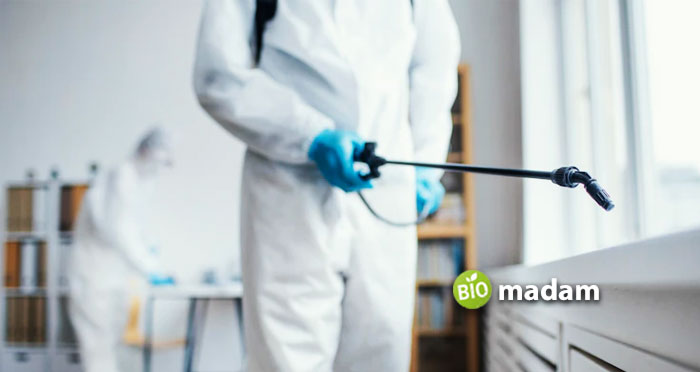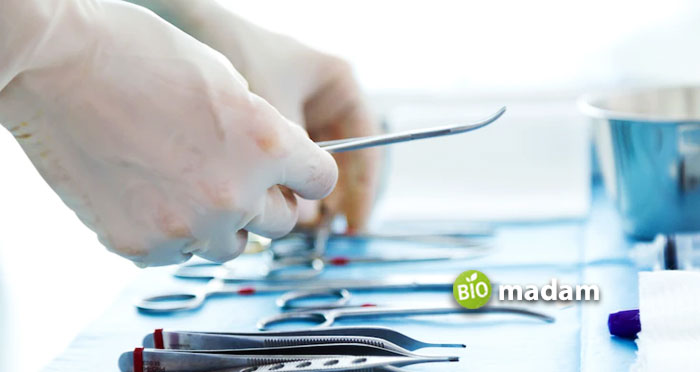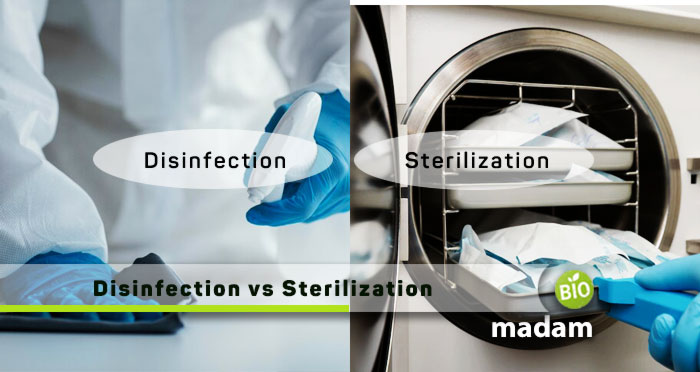There are several physical methods to create a microbe-free environment, including steaming, sanitation, sterilization, disinfection, etc. However, people often confuse these terminologies just like disinfection and sterilization are used interchangeably in everyday terms. However, from a scientific perspective, they are quite distinct.
Disinfection is a more common process used in our daily lives. It refers to reducing the number of microorganisms, including bacteria, viruses, and fungi, on a surface. On the other hand, sterilization means the removal of all kinds of microorganisms from any material. It is an essential process in chemical, food, pharmaceutical, and other industries where contamination must not occur. Sterilization kills all microbes, giving you a microorganism-free surface. Let’s tell you the differences between disinfection and sterilization.
Comparison Table
| Characteristic | Disinfection | Sterilization |
| Definition | Reducing microorganisms | Removing microorganisms |
| Bacterial Spores | Survive | Killed |
| Types | Physical & Chemical | Wet heat, dry heat, radiation, chemicals, etc. |
| Mediums | Gamma rays, KMnO4, Alcohol, Iodine, etc. | Autoclave, Dry heat oven, UV rays, Formaldehyde, etc. |
| Cleanliness | General use | Sterile areas |
| Wounds | Applicable | Not applicable |
| New Techniques | Cidex OPA | New Plasms Sterilizer |
| Applications | Homes, offices, public places, etc. | Laboratories & Surgical theatres |
| Examples | Cleaning, mopping, wound disinfection, etc. | Surgical equipment, micro lab instruments, etc. |
What is Disinfection?
Disinfection is one of the methods of decontamination. It helps remove microorganisms from a non-living surface. Unlike sterilization, disinfection is not effective against bacterial spores. Disinfection is carried out by using disinfectants that are effective against most microbes. Yet, disinfection does not remove all of the contaminants. It is used in homes, offices, and public places to prevent the transmission of infections and diseases. The types of disinfection will help you understand disinfection better.

Classification of Disinfection
There are various types of disinfection depending on the disinfectant used. The two major classifications of disinfection are physical and chemical disinfection.
Physical Disinfection
Physical disinfection utilizes physical means of killing germs. Some methods used in physical disinfection are UV rays, heat, gamma rays, X-rays, electron beam, and sonification. The sun is the central source of UV rays for disinfecting clothes. However, it is not suitable for disinfection or sterilization of medical instruments. Water disinfection facilities disinfect wastewater using gamma rays from radioisotopes. Moreover, electron generators produce electron beams onto flowing water for disinfection.
Chemical Disinfection
Chemical disinfection uses chemical solvents to disinfect surfaces and substances. Chemical agents like chlorine, bromine, iodine, copper, silver, KMnO4, alcohol, hydrogen peroxide, quaternary ammonium salts, alcohols, soaps, and detergents are used as disinfectants.
What is Sterilization?
Sterilization means the complete removal of microorganisms from any instrument or surface. Sterilization kills all life forms as opposed to disinfection. It also removes bacteria and bacterial spores from the material. Microbiologists and biologists sterilize the equipment before using it to ensure no contamination occurs. It is also a critical part of food preservation processes, pharmaceutical industry preparations, and surgeries. Unsterilized surfaces and instruments may lead to disease transmission and complications.
Classification of Sterilization
There are four basic types of sterilization – dry heating, wet heating, radiation, and chemicals. Here is a brief description of all of them.

Dry Heat
Dry heat is also known as baking. It is used for materials like powders, oils, fats, or those susceptible to rusting. As dry heat sterilization does not use water, it does not damage such substances. Dry heat sterilization requires you to bring the temperature of that object to 325F to kill microbes. You can use a dry oven or heat the object directly.
Wet Heat
Wet heat is also called autoclaving and is typically used for heat-labile substances. Autoclaving kills all bacterial spores and viruses effectively. It is the most widely used sterilization method as it does not involve direct heat. Steam generated by an autoclave has high penetration. Autoclave sterilization is also suitable for thick and dense objects.
Radiation
Besides disinfection, radiation also helps in sterilization. Sterilization through radiation utilizes x-rays, UV rays, and gamma rays. The UV rays from the sun cannot completely sterilize a surface as the penetration is limited in air. However, the effectiveness of UV rays is high in a laminar flow hood. X-rays and gamma rays are better at sterilization than UV rays. Yet, they are also more dangerous than X-rays.
Chemicals
Some materials may not be sterilized by heat or radiation. Many chemists, scientists, and other researchers use chemical solvents for such substances to avoid damage. Common chemical sterilizers are formaldehyde and hydrogen peroxide. Nevertheless, chemical sterilization is not the best choice to kill bacterial spores.
Difference Between Disinfection and Sterilization
Definition
Disinfection
Disinfection means the removal of most microorganisms from a surface or substance.
Sterilization
Sterilization refers to killing all microbes from a material or surface.
Target
Disinfection
Disinfection targets the majority of microorganisms. Yet, it does not kill bacterial spores.
Sterilization
On the other hand, sterilization kills all kinds of microorganisms, including bacterial spores and viruses.
Types
Disinfection
Disinfection is primarily of two types – physical disinfection and chemical disinfection.
Sterilization
Sterilization is of four types – dry heat, wet heat, radiation, and chemical solvents.
Mediums
Disinfection
Disinfection uses chemical and physical mediums to kill microorganisms like gamma rays, sonification, hydrogen peroxide, alcohol, iodine, KMnO4, detergents, etc.
Sterilization
Though, sterilization uses multiple other mediums to eradicate microorganisms from a surface. They include wet heat, dry heat, UV rays, x-rays, formaldehyde, etc.
Cleanliness
Disinfection
It is suitable for regular cleaning of surfaces for general use.
Sterilization
Conversely, sterilization is common in laboratories to clean surfaces where no contamination should occur.
Wounds
Disinfection
Wounds are usually disinfected using a mild disinfectant to avoid infection.
Sterilization
In contrast, you cannot sterilize wounds as the chemicals or heat may damage the skin surrounding the wound.
New Techniques
Disinfection
One of the new techniques and technologies for disinfection is the Cidex OPA (Ortho-phthalaldehyde) cleared by FDA.
Sterilization
In comparison, the latest technique introduced for sterilization is the New Plasms Sterilizer (Sterrad 50). It is cleared by FDA for the use which shows its effectiveness.
Applications
Disinfection
Disinfection is a commonly adapted cleanliness technique in homes, offices, and public places.
Sterilization
Alternatively, sterilization is typically applied in laboratories and sterile production facilities where no contamination must occur, like research labs.
Examples
Disinfection
Common examples of disinfection include cleaning surfaces with disinfection liquids, pasteurization, disinfection of wastewater, and disinfecting wounds with suitable solvents.
Sterilization
Examples of sterilization include sterilizing instruments in microbiology labs to cultivate cultures, surgical equipment, etc.
The Bottom Line
Disinfection and sterilization are the methods of decontamination. Their degree of cleanliness is the most basic difference between disinfection and sterilization. Disinfection refers to reducing microorganisms on a surface to avoid the transmission of diseases. Whereas sterilization means killing all microbes on a surface or material. Disinfection is common in homes, offices, and public places, while labs and surgical theatres require sterilization. They ensure that your material or instrument is clean. Commonly used disinfectants include alcohol and detergents. At the same time, wet heat and dry heat offer complete sterilization.
FAQs
What is the importance of sterilization?
Sterilization is essential when performing surgery or observing microbiological samples. It makes sure that another kind of culture does not mix with your specimen. Sterilizing surgical equipment ensures safety from pathogens during operation.
What are the methods of disinfection in hospitals?
Hospitals carry out disinfection using formaldehyde, hydrogen peroxide, alcohol, and chlorine compounds. Dry heat and steam under pressure provide proper sterilization.
Can disinfection reduce the risk of the spread of infection?
Yes, disinfection can reduce the risk of the spread of infection. While it may not kill all pathogens, disease transmission risk reduces considerably. You may also use a suitable sanitizer to avoid transmission of disease.

Hello, I would like to introduce myself to you! I am Chelsea Rogers, an experienced blog writer for science articles, holding an MPhil degree. My enthusiasm to grab the best knowledge, let it relate to botany, zoology, or any other science branch. Read my articles & let me wait for your words s in the comment section.

